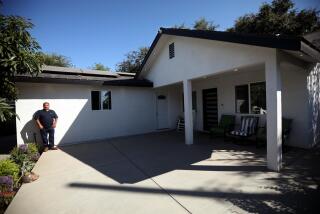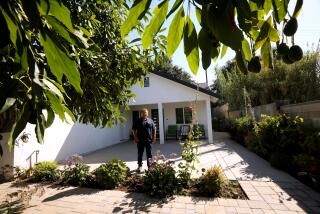New-Home Starts in State Drop a Surprising 8%
New-home building in California fell dramatically last month as developers pulled back amid escalating home prices, rising interest rates and early signs of an economic slowdown.
The big 8% drop in home-building permits in May, after double-digit increases in the first quarter, is a setback for a state in the throes of a severe housing crunch and home affordability crisis.
“This is a complete surprise,” said G.U. Krueger, deputy chief economist for the California Assn. of Realtors in Los Angeles.
Ben Bartolotto, research director for the Construction Industry Research Board in Burbank, said it appears that builders are reducing new development in anticipation of slackening demand. The availability of zoned land for development, a perennial problem for California builders, may also have contributed to the drop-off in permits.
If the weaker home-building trend continues, it will undoubtedly contribute to a slowing economy, affecting a wide range of businesses in construction and other industries. In a state desperate for more affordable housing, a cutback in building also will keep putting upward pressure on home prices and rents. That will make it harder for more families to attain a home.
In April, the number of home-building permits--which indicate development that is about to get underway--declined by 3% from a year earlier. Based on that month and figures for May, released this week by the California Department of Finance, builders statewide were on pace to put up about 130,000 houses and apartment units this year--significantly fewer than last year and way below projected needs.
“Given the demographic pressures and continued economic boom in California, we should be running at 200,000 to 250,000 per year,” Krueger said.
The drop in May permits mirrors a slowdown in U.S. housing starts reported earlier in the month. And in the latest bit of evidence that the country’s red-hot housing market is cooling, the government reported Thursday that sales of new homes nationwide dropped modestly in May following a sharp decline in April.
But unlike the nation, California has been significantly underbuilding to meet projected household and job growth. Economists have been expecting a catch-up of sorts for the last couple of years, but the building increases have consistently fallen short of expectations.
Between January and May, the building slowdown has been most pronounced in Marin, San Francisco and San Mateo counties, where housing permits were off by more than 28% from a year ago, according to the Construction Industry Research Board. Orange County is down more than 4% this year.
Permits in Los Angeles County increased by 34% so far this year, but even that is not considered big enough to meet the projected demand.
Jeff Meyers, chief executive of Meyers Group, an Irvine-based provider of new-home real estate information, said the lack of new-home construction will only drive up prices, making it harder for companies to recruit and retain workers. Worse, it might lead to an exodus of some businesses from the state, he said.
Only about 30% of the state’s families can afford to buy the typical home in California, compared with 55% for the nation as a whole, according to calculations by the state realty group.
James Pugash, chief executive at Hearthstone, a San Francisco-based investment house that finances residential construction, said the lack of building underscores what California builders have long complained about: the costly and time-consuming permitting process.
“We have a lot of land to build on in California, but you can’t get zoning to build on it,” he said.
The cost of clearing environmental and permitting hurdles in California can be upward of $50,000 for a single-family house--more than twice as much as in many other states, according to Meyers Group.
Land-use experts from UC Berkeley and state housing agencies recently reported that most of California’s crowded metropolitan areas contain enough developable land to house millions of new families through the next two decades.
However, local governments have not made residential development a priority, said UC Berkeley professor John Landis, principal author of the study. Instead, they generally favor the larger tax revenues that retail stores generate over the property taxes from housing projects, he said.
“Housing isn’t at the top of their agendas, because the people most affected by the lack of it are the poor, and they often don’t vote,” he said.
More to Read
Inside the business of entertainment
The Wide Shot brings you news, analysis and insights on everything from streaming wars to production — and what it all means for the future.
You may occasionally receive promotional content from the Los Angeles Times.










